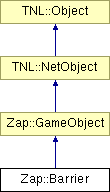|
|
|
|
Zap::Barrier Class Reference
#include <barrier.h>
Inheritance diagram for Zap::Barrier:

Detailed Description
The Barrier class represents rectangular barriers that player controlled Ship instances cannot pass through.Barrier objects, once created, never change state, simplifying the pack/unpack update methods. Barriers are constructed as an expanded line segment.
Public Types | |
| enum | { BarrierWidth = 50 } |
Public Member Functions | |
| Barrier (Point st=Point(), Point e=Point(), F32 width=BarrierWidth) | |
| Barrier constructor. | |
| void | onAddedToGame (Game *theGame) |
| Adds the server object to the net interface's scope always list. | |
| void | render (U32 layer) |
| renders this barrier by drawing the render line segments, | |
| S32 | getRenderSortValue () |
| returns a sorting key for the object. Barriers should sort behind other objects | |
| bool | getCollisionPoly (Vector< Point > &polyPoints) |
| returns the collision polygon of this barrier, which is the boundary extruded from the start,end line segment. | |
| bool | collide (GameObject *otherObject) |
| collide always returns true for Barrier objects. | |
| void | clipRenderLinesToPoly (Vector< Point > &polyPoints) |
| clips the current set of render lines against the polygon passed as polyPoints. | |
| TNL_DECLARE_CLASS (Barrier) | |
Data Fields | |
| Point | start |
| The start point of the barrier. | |
| Point | end |
| The end point of the barrier. | |
| F32 | mWidth |
| U32 | mLastBarrierChangeIndex |
| Index to check against the global counter - if it is different, then this barrier's polygon outline will be clipped against all adjacent barriers. | |
| Vector< Point > | mRenderLineSegments |
| The clipped line segments representing this barrier. | |
Static Public Attributes | |
| U32 | mBarrierChangeIndex |
| Global counter that is incremented every time a new barrier is added on the client. | |
Member Enumeration Documentation
|
|
|
Constructor & Destructor Documentation
|
||||||||||||||||
|
Barrier constructor.
|
Member Function Documentation
|
|
Adds the server object to the net interface's scope always list.
Reimplemented from Zap::GameObject. |
|
|
renders this barrier by drawing the render line segments,
Reimplemented from Zap::GameObject. |
|
|
returns a sorting key for the object. Barriers should sort behind other objects
Reimplemented from Zap::GameObject. |
|
|
returns the collision polygon of this barrier, which is the boundary extruded from the start,end line segment.
Reimplemented from Zap::GameObject. |
|
|
collide always returns true for Barrier objects.
Reimplemented from Zap::GameObject. |
|
|
clips the current set of render lines against the polygon passed as polyPoints.
|
|
|
|
Field Documentation
|
|
The start point of the barrier.
|
|
|
The end point of the barrier.
|
|
|
|
|
|
Global counter that is incremented every time a new barrier is added on the client.
|
|
|
Index to check against the global counter - if it is different, then this barrier's polygon outline will be clipped against all adjacent barriers.
|
|
|
The clipped line segments representing this barrier.
|
